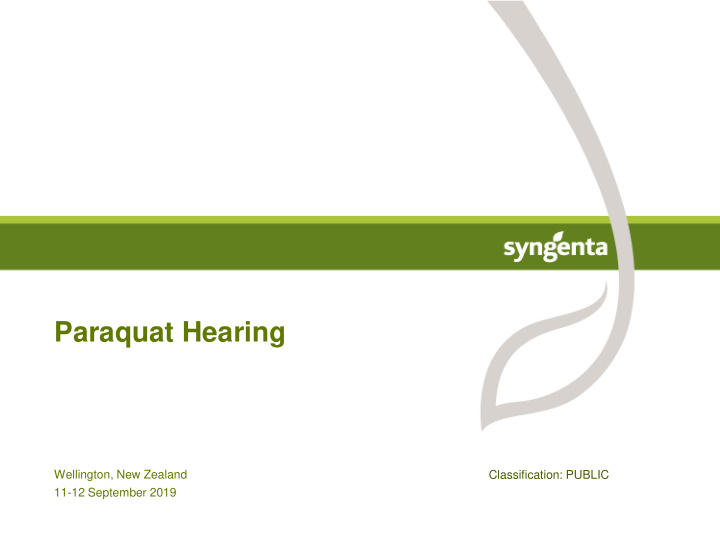



Paraquat Hearing Wellington, New Zealand Classification: PUBLIC 11-12 September 2019
Paraquat is an import tool for weed management ● Plays a critical role in environmentally sustainable farming practices around the world ● Use in conservation tillage to safeguard soil fertility - eradicates weeds without having to disturb the soil and disrupt the weed’s roots via tillage which can: o reduce soil erosion by up to 90 per cent, o significantly improve water retention and o increase/maintain carbon storage ● Once sprayed, paraquat kills the weeds and then becomes inactive in the soil – this allows rapid turnaround and planting of another crop. ● Reduces manual labour requirements – productivity and profitability can be increased ● Important rotational tool for farmers in the fight against glyphosate resistant weeds ● Value to New Zealand economy between $39 million and $75 million of annual GDP 2 Classification: PUBLIC
Syngenta supports the safe and sustainable use of paraquat ● Syngenta has actively participated in the reassessment of paraquat Data Call-in • Paraquat use information • 89 ecotoxicology studies • 149 environmental chemistry and fate studies • 168 toxicology studies Public submissions • Higher tier risk assessments for operator exposure and avian exposure plus supporting studies Public Hearing 3 Classification: PUBLIC
EPA Reassessment ● Syngenta agrees with the EPA control recommendations: o Impurity specifications and requirements for emetic and stenching agent o A maximum use rate of 600 g paraquat ion / ha o Proposed downwind buffer zones o Spray droplet specification for ground application and aerial application o Provision of responsible handling information o Limitations related to wind speeds and for transferring product into food, drink or unlabelled containers 4 Classification: PUBLIC
Closed Loop Knapsack Sprayer System Andy Cook, September 2019 Classification: PUBLIC
CLKS is a fully automated dosing system for knapsack sprayers Fill the knapsack with water, plug and go… 6 Classification: PUBLIC
Designed to bring growers multiple benefits Clean knapsack Recharge on the go Leak-free handle Knapsack only contains water * ; no Add on the sprayer system; just Ergonomic, safe, and retrofit-able need to replace knapsack plug in the cartridge and go Convenience Safe chemical handling The perfect dose Each cartridge allow for partial use and Empty cartridge can be rinsed Right for the farmer, lasts up to 6 knapsack refills of water thoroughly to allow safe disposal right for the environment *The design does not prevent users to add other liquids into their knapsacks 7 Classification: PUBLIC
CLKS fills the technology gap of closed-systems for knapsack users – many are smallholders For knapsack users: For large pump spray tank or tractor mounted sprayer users: CLKS Closed Transfer System (CTS) and Direct Injection System (DIS) By Syngenta with IP filing Already in the market; multiple vendors 8 Classification: PUBLIC
Key benefits – user and others OPERATORS ● No requirement for manual mixing / loading • Elimination of potential contact with the product concentrate (no skin or eye splashes / exposure) - No mixing / loading exposure component (as assumed in OHS models) • Elimination of possible dosing errors (too high or too low a spray solution concentration) • Saves time ● No requirement for manual rinsing (triple rinse) in order to be regarded as ‘non - hazardous’ waste (rinsing is built-in to the system) ● Water only in backpack / knapsack, in event of poorly maintained backpack developing a leak then only consequence for operator is getting wet (with water) ● Enables growers to also upgrade application accuracy with a new lance unit with nozzles matched to chemistry (correct droplet size and coverage), right dose rate. OTHERS ● No possibility of decanting of the product concentrate to inappropriate storage containers (no possibility of ‘confusion’ with beverages following removal from original sales container) • Elimination of accidental drinking accidents • Elimination of ‘impulsive’ acts of self -harm ● Applicable beyond Paraquat use. Potentially for all future knapsack use to better support reduced operator exposure 9 Classification: PUBLIC
Key points ● Can retrofit to existing backpack / knapsack sprayers - New lance unit only ● Developed by Syngenta with external specialist engineering design company (Sagentia) - Patent filing (to avoid possible blocking patents for a safety enhancement and ensure system specification meets standards required to deliver all benefits) ● Syngenta intend to make available for all paraquat registrants on cost neutral basis ● Sets a new and higher safety standard for other countries to follow ● Complements Worksafe proposal for future ‘closed transfer system’ approach for mixing / loading with tractor based systems 10 Classification: PUBLIC
Recommend
More recommend